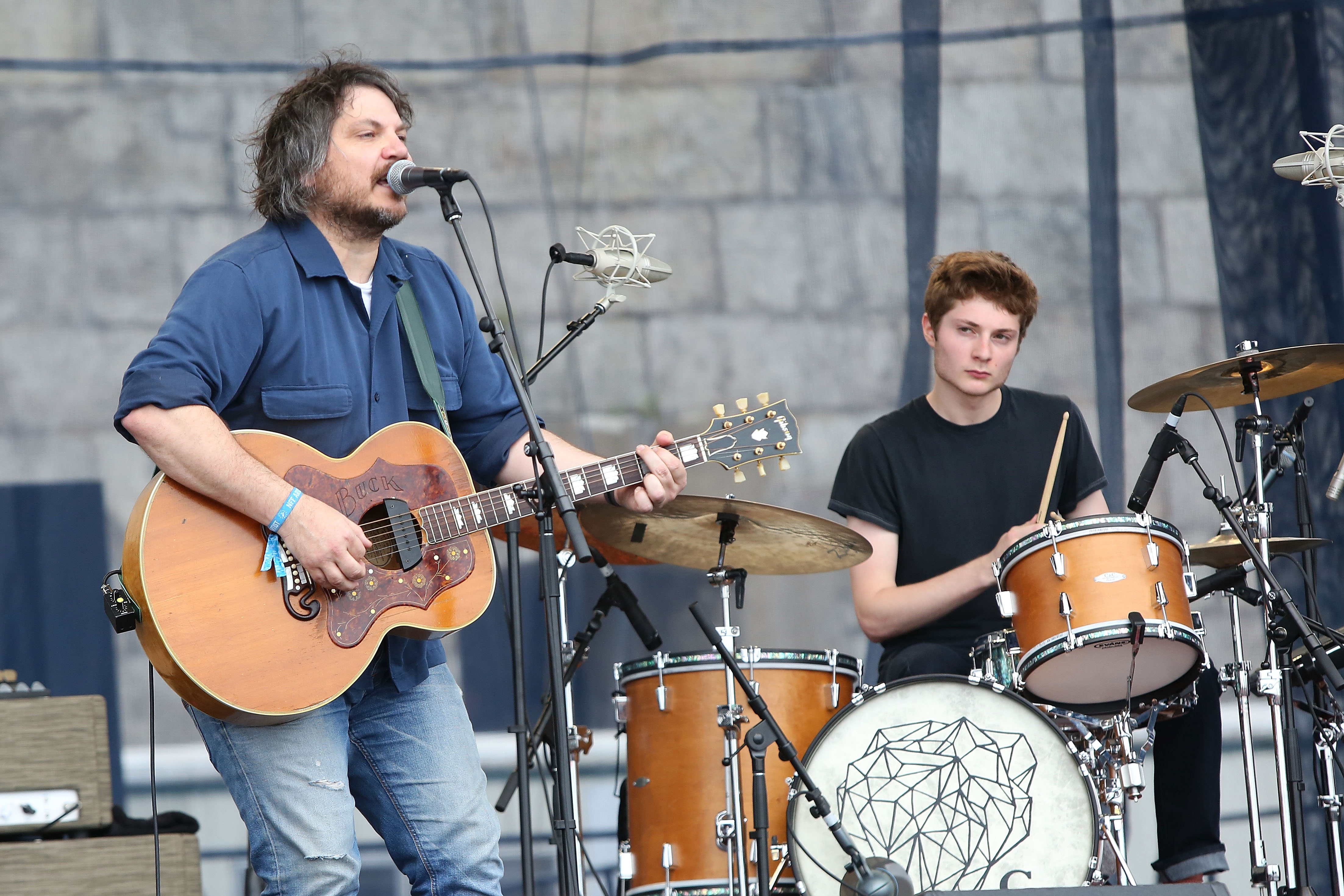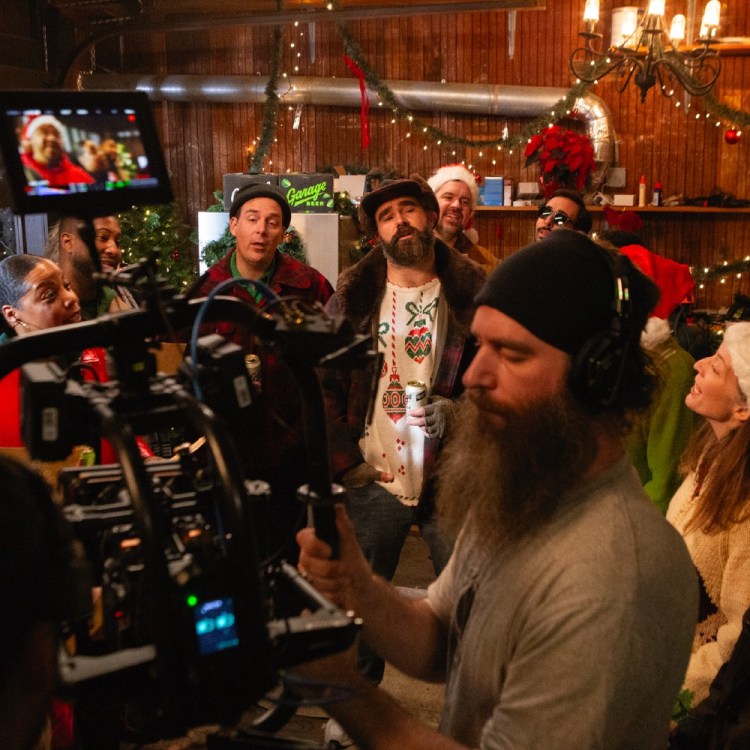When Fleet Foxes announced last year that the surprise release of Shore, their fourth studio album, would be timed to the autumnal equinox, dropping at the exact moment summer officially gave way to fall, it seemed like a no-brainer. In a lot of ways, the record is the band’s way of leaning in to the flannel-clad image many already have of them. “Summer is over” are the first words you hear on opening track “Wading in Waist-High Water,” and to drive home the seasonal shift, the album wraps up with Robin Pecknold singing, “Now the quarter-moon is out.” (As Pecknold recently told the Ringer, “coincidentally that’s the phase the moon that will be entering in on [September] 23.”) It’s an unabashedly fall record from a band whose music has always brought to mind crunchy leaves and decorative gourds, and releasing it at this particular time of year feels like a stroke of genius.
Of course, the Seattle indie-folk group is hardly the only one whose music just seems to hit differently between September and November. What exactly makes a great “fall album” is subjective, and it depends entirely on how you feel about the season. If you see it as a depressing buffer between summer relaxation and winter festivity when everything dies and you can never figure out the appropriate amount of layers to wear, maybe you turn to your favorite sad indie-rock guy with a guitar. But if you’re the first in line for a pumpkin-spiced latte in late August and you’ve already got your annual trip to Storm King plotted out to take in the gorgeous foliage, fall music likely means something a little more majestic, full of intricate arrangements to match the season’s scenery and warm, inviting sounds to usher in the start of sweater weather.
With that in mind, we’re highlighting the albums that remind us of fall below, whether they’re reminding us of the elegance of “Autumn in New York” or birthed from a remote hunting cabin in northwestern Wisconsin.
James Blake, Overgrown (2013)
The question isn’t whether a James Blake album belongs on this list; it’s which one? Before the uncharacteristically melodic and dare-I-say upbeat recordings on 2019’s Assume Form — an album that Blake made after falling in love with actor Jameela Jamil and moving to L.A., two decidedly sunny developments — Blake’s entire oeuvre was essentially autumnal: slow, dark, lonely, spectral. We could’ve opted for The Colour in Anything, but that felt a little too on the nose (just look at the album art). So let’s go with what most would consider Blake’s opus, Overgrown, an album full of moody, synth-drenched tracks like “Life Round Here” and “Retrograde” that pair well with late-night drives, rainy-day runs or lying awake in bed staring at the ceiling and questioning the meaningless of your own existence. If things get too dark, just remember: the guy who wrote these songs now lives in Hollywood, and is by all indications quite happy with how things have shaken out. — Walker Loetscher
Key Track: “Life Round Here”
Bruce Springsteen, The River (1980)
Born in the U.S.A. gets associated with summer for obvious reasons, but The River feels like The Boss’s autumn record. With several Darkness on the Edge of Town leftovers — including “Independence Day,” “The Ties That Bind” and “Point Blank” — finding their way onto its tracklist, it’s got a certain grimness to it that feels apropos for this time of year. Released right around the time that Springsteen turned 30, The River is full of anxiety about misspent youth and looming adulthood, perfect for revisiting as we bid a fond farewell to carefree summertime, start digging our warmer jackets out of storage and brace for bitter cold. If there’s a better way to revel in that gloominess than listening to Springsteen wail “is a dream a lie if it don’t come true?” on the title track, I don’t know what it is. — Bonnie Stiernberg
Key track: “The River”
Townes Van Zandt, High, Low and In Between (1971)
If your idea of a great fall album is one that sounds best while you’re 19 years old, driving around smoking cigarettes on the first cold night of the season and thinking about the crushing irony that so many of the artists who provide solace when we need it most, a glimmer of hope and a reminder that there is good all around us, are ultimately unable to find that same solace in their own lives, then boy have I got just the album for you. High, Low and In Between is Townes at his best: comforting and understanding, troubled but determined. The recording is warm and welcoming the way almost none are anymore, and the melodies are simple and familiar. I’m gonna go ahead and call “Your Are Not Needed Now” the key track because the chorus can make me cry like a baby if I’m not careful (especially this live version, sheesh), but you’ve also got “To Live Is to Fly” and “Greensboro Woman” on here, so take your pick. — Mike Conklin
Key track: “You Are Not Needed Now”
Alvvays, Alvvays (2014)
There’s something about jangle-pop that feels especially fall-like — too laidback for summer, but too warm and bright to belong on a winter playlist — and Alvvays’s 2014 self-titled debut is no exception. The Canadian group is flawless here, from the dreamy surf-tinged opener “Adult Diversion” to their undeniably catchy “Archie, Marry Me” to the excellent “Party Police,” where frontwoman Molly Rankin laments seasons past: “Fighting through the fog,” she sings. “I can’t believe it rained all summer long.” — Bonnie Stiernberg
Key track: “Archie, Marry Me”
Yo La Tengo, I Can Hear the Heart Beating As One (1997)
Putting aside the fact that the album has the song “Autumn Sweater” on it, the New Jersey trio’s 1997 record is also an hour and eight minutes of perfect autumnal driving music, the perfect leaf-peeing score. “Moby Octopad,” with its little piano twinkle, makes for the perfect open-road jam, while “Shadows” and “Stockholm Syndrome” are the perfect songs for parking your car and enjoying the scenery as you sip on something warm. — Jason Diamond
Key track: “Stockholm Syndrome”
Vampire Weekend, Vampire Weekend (2008)
Even deep into adulthood, fall still conjures up that back-to-school feeling. (Perhaps Tom Hanks put it best in You’ve Got Mail when he said, “Don’t you love New York in the fall? It makes me want to buy school supplies. I would send you a bouquet of newly sharpened pencils if I knew your name and address.”) No album makes me want to buy school supplies more than Vampire Weekend’s self-titled debut — yes, because I happened to be in college when it came out, but also because everything about it feels downright collegiate, from the harpsichord and other baroque touches on “M79” to the AP Style lesson of “Oxford Comma” and, obviously, the lovelorn lyrics of “Campus.” — Bonnie Stiernberg
Key track: “M79”
Bon Iver, For Emma, Forever Ago (2007)
Justin Vernon’s debut LP as Bon Iver is one of those albums that you can’t really talk about without acknowledging the origin story that has since become a fixture of folk-rock lore. The studio of record in the liner notes? Vernon’s father’s hunting cabin in Northwestern Wisconsin, where he sought refuge after a bad breakup and wasting away his savings playing online poker. It was there that Vernon drank beer, hunted, stacked lumber and wrote somber ballads about loneliness and falling out of love for three months, eventually delivering For Emma, the quiet, contemplative nine-track record that would launch him to indie-rock stardom. — Walker Loetscher
Key track: “Skinny Love”
Nick Drake, Bryer Layter (1971)
Cult-favorite British folk singer Nick Drake has long been synonymous with fall, his outrageously deft, dizzying acoustic guitar playing and world-weary vocals providing all the melancholy one expects from the season. But there’s also a stately elegance at play on Bryer Layter — thanks to some meandering piano lines and orchestral flourishes — that keeps it from dragging you under completely. — Mike Conklin
Key Track: “One of These Things First”
Louis Armstrong and Ella Fitzgerald, Ella and Louis Again (1957)
Actual autumn in New York City, the time when it’s cool and crisp, the leaves are the perfect shades of orange and brown, and the city feels cozy as hell, lasts about five days. That’s what makes “Autumn in New York” such a perfect seasonal song. You have to enjoy it to the fullest extent, and these two legends serve up what might be the best version of the standard. That, and the rest of the record has serious “Meg Ryan and Billy Crystal walking around Central Park in late-October” vibes. — Jason Diamond
Key track: “Autumn in New York”
Lou Reed, New York (1989)
For me, fall always conjures up images of wandering around New York City, which is what pretty much all of Lou Reed’s post-Velvets work does — even the albums that aren’t called New York and don’t happen to include a song called “Halloween Parade.” If you’re so inclined, the album just got the deluxe treatment, featuring three CDs, a DVD and two LPs, with 26 previous unreleased recordings included, and it is fantastic. — Mike Conklin
Key track: “Halloween Parade”
The Cure, Disintegration (1989)
Everybody knows fall is the most goth season: it’s got Halloween, sure, but also generally speaking, it’s when it starts getting darker earlier and everything dies. What better time to embrace the angst and revisit this classic from Robert Smith and company? Fall’s not all pumpkin spice lattes and hay rides; sometimes it’s shivering in a too-light jacket on that first truly chilly night of the year as you walk home alone looking over your shoulder while listening to “Lullaby.” — Bonnie Stiernberg
Key track: “Pictures of You”
Kanye West, Late Registration (2005)
It’s easy to forget that before the MAGA hats and the Kardashians and the God complex, Kanye West was best known for branding himself as the rap game’s resident petulant undergrad. His mother was a college professor, his personal style tended toward popped collars and leather backpacks, and there was the very literal collegiate naming convention behind his first three albums: 2004’s College Dropout, 2005’s Late Registration and 2007’s Graduation. But it’s not just the allusions to campus life that make his sophomore album the most fall-appropriate — it’s the fact that he recruited film composer and frequent Fiona Apple collaborator Jon Brion to co-produce. With his signature Motown samples backed by Brion’s lush string arrangements (“Gone”; “Bring Me Down”) and the occasional burst of a horn section (“Touch the Sky”; “We Major”), Kanye’s music waded into darker, more ambitious territory for the first time. — Walker Loetscher
Key track: “Gone”
John Fahey, Blind Joe Death (1959)
You can run your finger up and down the discography of the guy that’s the undisputed champ of what’s often called “American primitive,” but for sake of argument, his first full-length from 1959 is particularly great for long walks in the woods that require a flannel. — Jason Diamond
Key track: “West Coast Blues”
Ramones, Ramones (1976)
I can’t explain why exactly I’ve come to associate fall with punk rock (besides the obvious Misfits/Halloween connections). Is it because it’s leather jacket weather? Is P.J. Soles responsible for some sort of subconscious Rock N Roll High School/Halloween association in my brain? Whatever the reason, September through November is Ramones season as far as I’m concerned, and there’s no better place to start than their self-titled debut. — Bonnie Stiernberg
Key track: “Judy Is a Punk”
Bill Withers, Just As I Am (1971)
Usually when I think of soul music — and its later, more danceable derivatives funk and disco — I think of summer. And that feeling extends to “Harlem,” the foot-stomping first track of Just as I Am, Bill Withers’s seminal 1971 album: “Summer night in Harlem,” he sings, “It’s too hot to sleep.” But from there things take a decidedly autumnal turn — the very next track, after all, is called “Ain’t No Sunshine,” and sparse production abounds throughout, including on my two favorite cuts, “Hope She’ll Be Happier” and “Grandma’s Hands.” Robert Christgau once wrote that “Withers is more folk than pop, and … adds a folk seriousness to a gospel fervor.” I think what that means is that where most soul music is jubilant, Withers tends toward melancholy, and in doing so, makes perfect music for transitioning to fall. — Walker Loetscher
Key track: “Hope She’ll Be Happier”
Akron/Family, Akron/Family (2005)
A since-overlooked band that first made waves at the tail end of the “freak-folk” thing that happened in Williamsburg, Brooklyn, in the early aughts, Akron/Family’s first album is full of gently swirling, multi-layered acoustic guitars and disarmingly close-sounding, almost muffled vocals. Hiding just beneath the surface are some of the most beautiful melodies you’ve ever heard. — Mike Conklin
Key track: “I’ll Be on the Water”
Jackson C. Frank, Jackson C. Frank (1965)
Autumn is the perfect season for your moody, possibly tragic folkies, from Nick Drake to Karen Dalton, but there is something particularly spooky about Jackson C. Frank’s Paul Simon-produced 1965 album that makes it perfect for those days when you’re feeling contemplative. — Jason Diamond
Key track: “Blues Run the Game”
Wilco, Being There (1996)
There are moments on this sprawling double album that seem tailor-made for summer; upbeat tracks like “Monday” and “I Got You (At the End of the Century” would be right at home at a backyard BBQ. But it’s the slower, more contemplative tracks that ultimately set the tone. Songs like “Far Far Away,” “Forget the Flowers,” “Sunken Treasure” and “Red Eyed and Blue” — all of them among the most enduring of Tweedy’s career — perfectly capture that moment each year when music starts sounding better in isolation than it does in a crowd. And let’s not underestimate the fact that the first line on the record is, “When you’re back in your old neighborhood, cigarettes taste so good.” — Mike Conklin
Key track: “Misunderstood”
Perfume Genius, Too Bright (2014)
Perfume Genius’s Mike Hadreas’s voice has a certain elegance to it that reminds me of the best autumn can offer; whether he’s backed by sparse piano or strings or driving synth, on Too Bright he confronts his fears and feelings of inadequacy head-on with stunning results that bring to mind the most extravagant fall colors. — Bonnie Stiernberg
Key track: “Queen”
Grizzly Bear, Shields (2012)
In truth, Grizzly Bear’s entire oeuvre of quiet, densely layered psych-folk is fall appropriate (as my colleague Mike Conklin puts it, they “might be the most boring band ever to be as successful as they are”). But their fourth album stands out for me because it came on the heels of Veckatimest, which was released in May and then bleated through college radio stations all summer long thanks to what can safely be called the band’s one true summer anthem, “Two Weeks.” From there, the band could have leaned into the poppier sensibilities of that song and made a play at mainstream stardom; instead, they returned with their most baroque and challenging album to date, loaded with carefully calibrated tracks like “Sleeping Ute,” “Half Gate” and “Sun in Your Eyes” that reward patience and repeat listens with booming third-quarter crescendos. It’s the kind of record you have to listen to the same way you read a book: intently, without distraction. And that’s something I only have time for in fall. – Walker Loetscher
Key track: “Sleeping Ute”
Mount Eerie, Lost Wisdom (2008)
Most of Phil Elverum’s discography lends itself to the end of the calendar year, perfect for warmer Indian summer days and those freak times when the snow falls before Thanksgiving. But this, his second full-length under the Mount Eerie moniker, has a particular sitting around a fire when it gets cold enough to start seeing your breath. — Jason Diamond
Key track: “Lost Wisdom”
Fleet Foxes, Helplessness Blues (2011)
As mentioned earlier, there’s perhaps no band from the past decade or so who feels as fall-like as Fleet Foxes. Subsequent efforts have been lovely and impressive, but Helplessness Blues still stands as their masterpiece, full of lush arrangements, gorgeous harmonies (aided in part by the fact that it’s the only album of theirs to feature former member Josh Tillman, aka Father John Misty, on drums and backing vocals) and autumnal vibes. — Bonnie Stiernberg
Key track: “Helplessness Blues”
Vince Guaraldi, It’s the Great Pumpkin, Charlie Brown: Music from the Soundtrack (2018)
The ultimate autumn soundtrack comes with a stipulation: you can only really start listening to it during the last few days of September and should probably cut it out after October 31. There are a few tracks you can put on mixes that are perfect for until Thanksgiving, but for the most part, you’ve got a solid month with this one. — Jason Diamond
Key track: “The Great Pumpkin Waltz”
Simon & Garfunkel, Bridge over Troubled Water (1969)
It’s tough to choose which Simon & Garfunkel album feels the most like fall because they all conjure up images of changing leaves and crisp air, but perhaps none captures sweater weather better than the legendary duo’s final effort, the masterful Bridge over Troubled Water. (Just look how cozy Paul Simon looks on the cover.) — Bonnie Stiernberg
Key track: “The Boxer”
The Clean, Anthology (2002)
Fall is about death in a lot of ways, but it’s also about rebirth and fresh starts, and that’s why this collection of early, previously out-of-print releases by New Zealand’s The Clean comes on heavy rotation this time of year for me. It’s hard to argue with the optimism of “anything could happen, and it could be right now.” — Bonnie Stiernberg
Key track: “Anything Could Happen”
This article appeared in an InsideHook newsletter. Sign up for free to get more on travel, wellness, style, drinking, and culture.






















